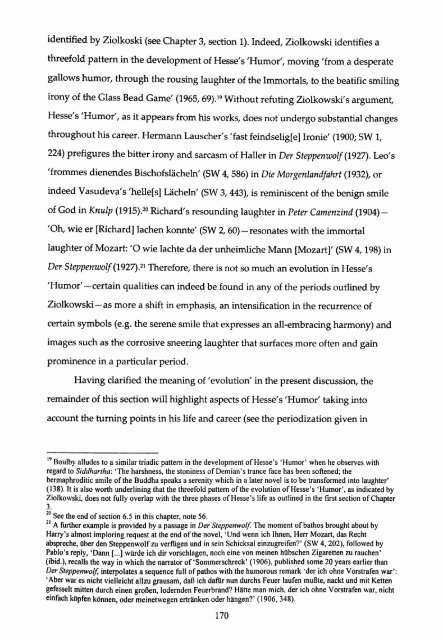HERMANN HESSE AND THE DIALECTICS OF TIME Salvatore C. P. ...
HERMANN HESSE AND THE DIALECTICS OF TIME Salvatore C. P. ...
HERMANN HESSE AND THE DIALECTICS OF TIME Salvatore C. P. ...
You also want an ePaper? Increase the reach of your titles
YUMPU automatically turns print PDFs into web optimized ePapers that Google loves.
identified by Ziolkoski (see Chapter 3, section 1). Indeed, Ziolkowski identifies a<br />
threefold pattern in the development of Hesse's 'Humor', moving 'from a desperate<br />
gallows humor, through the rousing laughter of the Immortals, to the beatific smiling<br />
irony of the Glass Bead Game' (1965, 69). 19 Without refuting Ziolkowski's argument,<br />
Hesse's 'Humor', as it appears from his works, does not undergo substantial changes<br />
throughout his career. Hermann Lauscher's 'fast feindselig[e] Ironie' (1900; SW 1,<br />
224) prefigures the bitter irony and sarcasm of Haller in Der Steppenwolf (1927). Leo's<br />
'frommes dienendes Bischofslacheln' (SW 4, 586) in Die Morgenlandfahrt (1932), or<br />
indeed Vasudeva's 'helle[s] Lacheln' (SW 3, 443), is reminiscent of the benign smile<br />
of God in Knulp (1915). 20 Richard's resounding laughter in Peter Camenzind (1904)<br />
'Oh, wie er [Richard] lachen konnte' (SW 2, 60)-resonates with the immortal<br />
laughter of Mozart: 'O wie lachte da der unheimliche Mann [Mozart]' (SW 4,198) in<br />
Der Steppenwolf (1927) * Therefore, there is not so much an evolution in Hesse's<br />
'Humor' certain qualities can indeed be found in any of the periods outlined by<br />
Ziolkowski as more a shift in emphasis, an intensification in the recurrence of<br />
certain symbols (e.g. the serene smile that expresses an all-embracing harmony) and<br />
images such as the corrosive sneering laughter that surfaces more often and gain<br />
prominence in a particular period.<br />
Having clarified the meaning of 'evolution' in the present discussion, the<br />
remainder of this section will highlight aspects of Hesse's 'Humor' taking into<br />
account the turning points in his life and career (see the periodization given in<br />
19 Boulby alludes to a similar triadic pattern in the development of Hesse's 'Humor' when he observes with<br />
regard to Siddhartha: 'The harshness, the stoniness of Demian's trance face has been softened; the<br />
hermaphroditic smile of the Buddha speaks a serenity which in a later novel is to be transformed into laughter'<br />
(138). It is also worth underlining that the threefold pattern of the evolution of Hesse's 'Humor', as indicated by<br />
Ziolkowski, does not fully overlap with the three phases of Hesse's life as outlined in the first section of Chapter<br />
3.<br />
20 See the end of section 6.5 in this chapter, note 56.<br />
21 A further example is provided by a passage in Der Steppenwolf. The moment of bathos brought about by<br />
Harry's almost imploring request at the end of the novel, 'Und wenn ich Ihnen, Herr Mozart, das Recht<br />
abspreche, uber den Steppenwolf zu verfugen und in sein Schicksal einzugreifen?' (SW 4, 202), followed by<br />
Pablo's reply, 'Dann [...] wurde ich dir vorschlagen, noch eine von rneinen hubschen Zigaretten zu rauchen'<br />
(ibid.), recalls the way in which the narrator of'Sommerschreck' (1906), published some 20 years earlier than<br />
Der Steppenwolf, interpolates a sequence full of pathos with the humorous remark 'der ich ohne Vorstrafen war':<br />
' Aber war es nicht vielleicht allzu grausam, daB ich daftir nun durchs Feuer laufen muBte, nackt und mit Ketten<br />
gefesselt mitten durch einen grofien, lodernden Feuerbrand? Hatte man mich, der ich ohne Vorstrafen war, nicht<br />
einfach kOpfen kOnnen, oder meinetwegen ertranken oder hangen?' (1906, 348).<br />
170
















